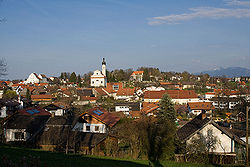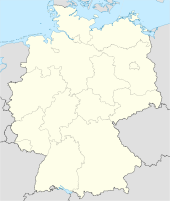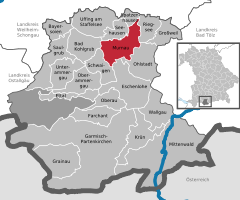- Murnau am Staffelsee
-
Murnau Murnau in 2007 
Coordinates 47°41′N 11°12′E / 47.68333°N 11.2°ECoordinates: 47°41′N 11°12′E / 47.68333°N 11.2°E Administration Country Germany State Bavaria Admin. region Upper Bavaria District Garmisch-Partenkirchen Mayor Michael Rapp (CSU) Governing party CSU Basic statistics Area 38.05 km2 (14.69 sq mi) Elevation 650 - 730 m Population 12,262 (31 December 2010)[1] - Density 322 /km2 (835 /sq mi) Other information Time zone CET/CEST (UTC+1/+2) Licence plate GAP Postal code 82418 Area codes 0 8841 Website www.murnau.de Murnau am Staffelsee is a market town in the district of Garmisch-Partenkirchen, in the Oberbayern region of Bavaria, Germany.
Murnau is situated on the edge of the Bavarian alps, approx. 70 km south of Munich. Directly to its west is the Staffelsee lake.
Contents
History
Murnau was first documented in 1150. It received the right to hold markets from Louis V, Duke of Bavaria, in 1350 and retains the title of "Markt" ("market") until today.
The town suffered a major fire in the year of 1835 and was subsequently almost completely rebuilt. During World War II a Nazi POW camp for Polish officers was located there.
Infrastructure
Murnau is a minor train hub, since it is the place where the Munich-Garmisch-Partenkirchen and the Oberammergau train lines intersect. The first electrical signal box of the Deutsche Bundesbahn was installed here. Also, the A95 motorway and the B 2 Bundesstrasse run through or near Murnau.
Another major feature is the Berufsgenossenschaftliche Unfallklinik, a hospital specializing in trauma surgery.
Murnau is used as a health resort by many guests.
Murnau has two elementary schools, the "James-Loeb-Grundschule" and the "Emmanuel-von-Seidl-Schule", the gymnasium "Staffelsee-Gymnasium" and the general school "Max-Dingler-Hauptschule".
Notable persons
For such a small town, Murnau has attracted quite a few noteworthy citizens over the years. Gabriele Münter and Wassily Kandinsky of the Blaue Reiter artistic collective lived there for several years. Ödön von Horvath spent a large part of his youth and young adulthood there and based some of his most well-known works (e.g. Jugend ohne Gott, Italienische Nacht) on happenings during the Third Reich in Murnau. Christoph Probst, executed by the Gestapo for being a member of the White Rose resistance group during the Third Reich, was born in Murnau. Filmmaker F.W. Murnau probably took his assumed name from the town, though there is no real factual evidence for this. Contemporary luthier Michael Koeberling lives and works in Murnau.
References
- ^ "Fortschreibung des Bevölkerungsstandes" (in German). Bayerisches Landesamt für Statistik und Datenverarbeitung. 31 December 2010. https://www.statistikdaten.bayern.de/genesis/online?language=de&sequenz=tabelleErgebnis&selectionname=12411-009r&sachmerkmal=QUASTI&sachschluessel=SQUART04&startjahr=2010&endjahr=2010.
External links
- Official site
- Murnau Castle Museum (German)
- Münterhaus Museum (German)
- Webcam: Pedestrian Precinct (German)
- Berufsgenossenschaftliche Unfallklinik Murnau
- Staffelsee-Gymnasium Murnau (German)
- Max-Dingler-Hauptschule Murnau (German)
Bad Bayersoien | Bad Kohlgrub | Eschenlohe | Ettal | Farchant | Garmisch-Partenkirchen | Grainau | Großweil | Krün | Mittenwald | Murnau am Staffelsee | Oberammergau | Oberau | Ohlstadt | Riegsee | Saulgrub | Schwaigen | Seehausen am Staffelsee | Spatzenhausen | Uffing | Unterammergau | WallgauCategories:- Municipalities in Bavaria
- Garmisch-Partenkirchen district
- Upper Bavaria geography stubs
Wikimedia Foundation. 2010.



